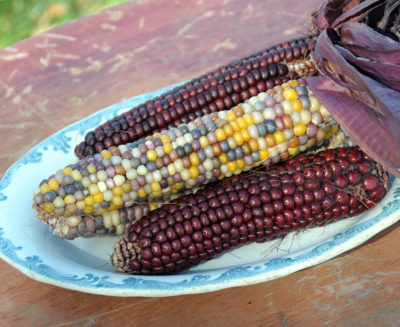Growing Ornamental Corn.
A beautiful fall decoration, ornamental corn is very popular at farm markets. Growing your own is just like cultivating sweet corn. (There are those who use it as a flour corn, but we have not tried it.)
Plant 1/4 lb. for 100 feet of row, 8 to 12 lb. per acre. The fresher sweet corn is, the better the flavor. Plant for succession, using some of the extra early, early and main crop varieties. A month to six weeks later plantings of early sorts may be made for late use. We suggest plantings of Corn seed at 10-day intervals until July 1st is this latitude. If white and yellow corns are planted adjoining, cross-pollination will cause the ears to produce some off-color kernels. Do not plant sweet corn near field corn. It is better to use three or four short rows instead of one long one. Transfer of pollen is better resulting in more desirable ears. Warm weather, moderate moisture and rich soil are desirable, but most garden soil will do if worked deeply and thoroughly before planting. Wait until the ground is warm to avoid the seed rotting. Rows may be spaced 2 1/2 to 4 feet apart. Use a wider planting for taller varieties. In drills, plant 5 to 6 seeds to the foot; in hills, 5 to 6 seeds per hill. Depending on soil conditions, soil crusting can be a serious issue for sprouting after heavy rains or overhead watering. Soil crust (compaction) creates a harder layer of soil that the germinating seeds cannot push through, and even small differences in soil or rainfall can make a big difference in how well the seed germinates. When plants are about 5 inches tall, thin to 6 to 12 inches apart. Cultivate well and keep free from weeds. Use manure that has been aged at least 1 year and plow in deeply. Minimum soil temperature of 55 degrees Fahrenheit at 4 inch depth.
Indian corn is ready to harvest when the husk and the ears are no longer green and fully mature. Leave the husks on for one week, then remove to finish drying.
Good companion crops are peas, pole beans, cucumbers, pumpkin, squash, melons and marigolds. A bad companion crop is tomatoes.
Growing Ornamental Corn.
A beautiful fall decoration, ornamental corn is very popular at farm markets. Growing your own is just like cultivating sweet corn. (There are those who use it as a flour corn, but we have not tried it.)
Heirloom Indian Ornamental corn seeds require fertile ground and should be planted in blocks rather than long rows for pollination. Full sun and warm weather are a must. In cooler climates, using old milk jugs helps hasten the harvest, but starting corn inside is not recommended. Plant corn seeds 1″ to 2″ deep, 4″ to 6″ in 2 1/2′ to 3′ wide rows, two weeks after the last spring frost. (Corn seed planted too early may rot.) Water well after planting and keep moist during germination. When plants are 3″ to 4″ tall, thin to 8″ to 12″ apart. Corn is designed to grow fast, so periodic fertilizing is recommended. Take care not to damage the roots while weeding. In dry conditions, keep the shallow roots well watered.
Indian corn is ready to harvest when the husk and the ears are no longer green and fully mature. Leave the husks on for one week, then remove to finish drying.
Good companion crops are peas, pole beans, cucumbers, pumpkin, squash, melons and marigolds. A bad companion crop is tomatoes.


